When it comes to survival situations, every advantage you can give yourself counts, especially when it comes to catching food.
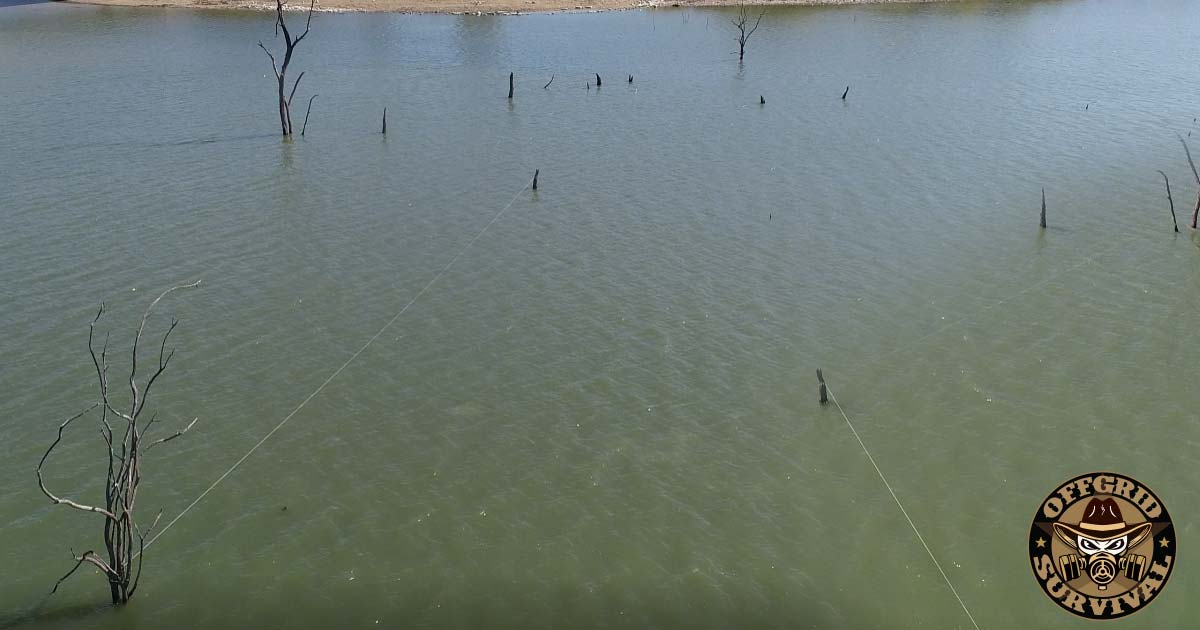
Enter the mighty trotline – a clever fishing system that allows you to maximize your chances of landing a lot of fish without constantly monitoring your line or expending a lot of energy and effort. It’s a time-tested technique that can make all the difference in a survival situation, and we’re about to dive into the details of this ingenious fishing method. So, get ready to learn how to set up a trotline and increase your chances of a successful catch, even in the most challenging circumstances!
What is a Trotline?
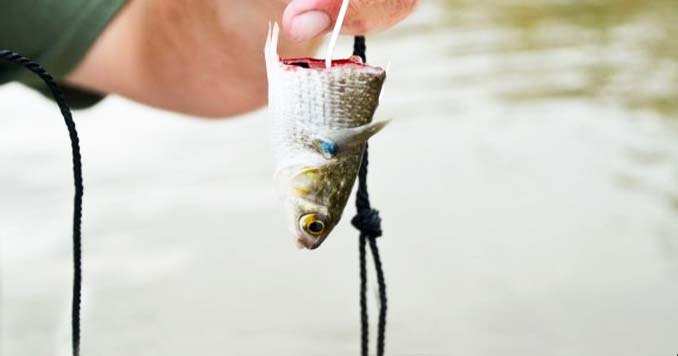
A Trotline is basically a long line or rope, with a number of smaller lines (known as trots, snoods or droplines) attached to the main line with either swivels or knots. The droplines have hooks and are baited for whatever fish you are going after – in most cases probably catfish.
The thing I like about this style of fishing, is you can use a trotline to completely cover the width of a river, stream or creek; giving you a good chance of catching passing fish. In a survival situation, we call this a passive method of gathering food, because once it’s set you can move on to other important survival-related tasks while the trotline works for you 24/7.
You can set your trotline out in the morning, and then check it in the evening – or vice versa.
While these can be set up as passive traps, to really get the most out of your trotlines check them every couple of hours. This gives you the opportunity to rebait empty hooks and allows you to catch even more fish.
History of the Trot Line
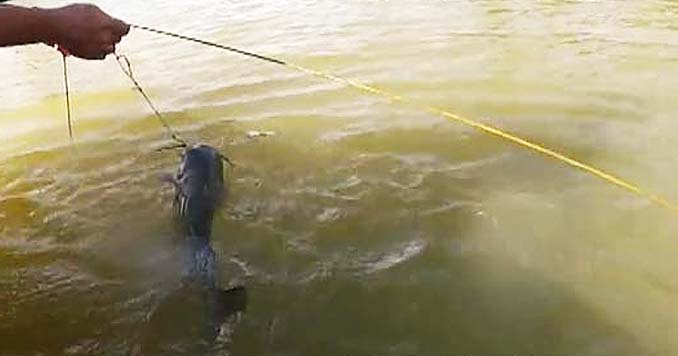
Trotlines have a rich history that spans back centuries, with evidence of their use dating back to ancient civilizations such as the Egyptians and the Chinese. These early fishermen used primitive forms of trotlines made from natural materials like plant fibers and animal sinews to catch fish from rivers, lakes, and oceans.
Over time, these setlines evolved and became more sophisticated. In medieval Europe, trotlines made from horsehair were commonly used, and they were even mentioned in historical texts and folklore. As fishing techniques advanced, trotlines were made from different materials, such as modern-day fishing lines and hooks, and are used in various environments around the world, from the icy waters of Scandinavia to the warm shores of the Caribbean.
This age-old technique has been a staple of traditional fishing practices in the South for generations, passed down through the years as a reliable way to harvest fish from rivers, lakes, and coastal waters. In the Southern United States, trotlines are commonly used to target popular fish species such as catfish, crappie, and bass. Many Southern anglers rely on trotlines as a dependable method to provide a fresh catch for their families, especially in rural or remote areas.
Trotlines are typically set up with multiple hooks attached to a main line, which is anchored in place and left in the water for a period of time, allowing the fish to be caught passively. One of the key benefits of trotlines is their versatility. Depending on the target fish species and the fishing environment, they can be set up in different configurations, such as stretched across a river or hung from a dock. Trotlines can also be customized with various baits, lures, and hooks to attract specific fish, making them a flexible and adaptable fishing method.
What can you catch on a Trotline?
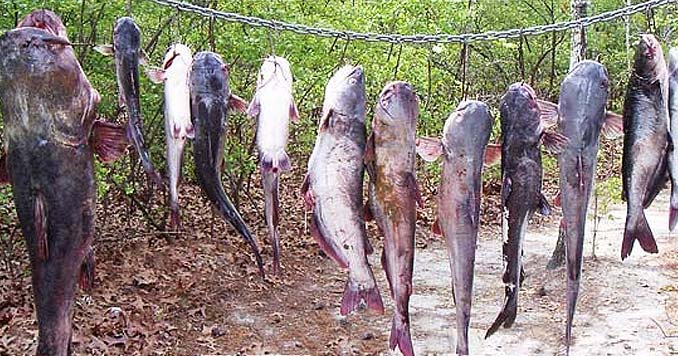
Trotlines are especially effective when trying to catch almost any kind of catfish. While catfish is your most likely catch, you can catch just about any type of fish using these lines, and they can even be an effective way of catching turtles and crabs.
This type of fishing is extremely effective and versatile. In fact, many, Blue Crab fisherman run a variation of a trot line where the mainline is completely anchored to the floor, allowing the crabber to work large areas of water without a lot of effort.
Survival Fishing Hacks: How to make a Trotline for Fishing
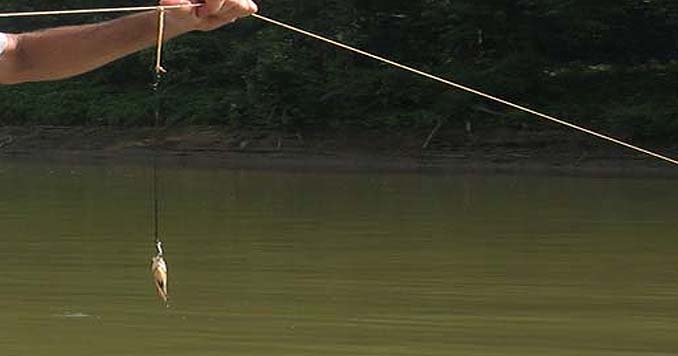
Building a trotline is actually pretty simple. During a non-survival situation, I often build them using basic supplies like paracord for the main line and swivels with an attached braided dropline and a baited hook. During a survival situation, you can use whatever you have.
Making a trotline requires some basic fishing gear and materials. Here’s a step-by-step guide on how to make a simple trotline:
Alright, first things first! You’ll need some basic fishing gear for making a trotline.
- Mainline: Grab a strong and durable fishing line, preferably nylon or polypropylene, about 100 to 200 feet long.
- Drop lines: Shorter lines (about 2-3 feet each) attached to the mainline at regular intervals, usually spaced about 3-5 feet apart, with a swivel or clip on the end for attaching hooks and bait.
- Hooks: Choose appropriate hooks for your target fish species, such as circle hooks or J-hooks.
- Bait: Select bait that is attractive to the fish species you are targeting, such as worms, cut bait, or live bait.
Set Up the Mainline. Next, scout out a good location along the waterbody where you want to set up your trotline. It could be a river, a dock, or a spot near some trees.
If you’re heading to a sprawling lake or reservoir, look for a couple of trees jutting out from shallow waters. Your trotline should be long enough to span the distance between the trees. On the other hand, if you’re targeting rivers and creeks, you’ll need to consider the fishing spot. Catfish tend to gravitate towards shallow flats adjacent to deeper waters, and these flats may only run along the bank for short distances. In such scenarios, a shorter trotline could suffice. However, if you’re looking to go all out and span bank to bank, a longer trotline will be necessary.
Once you’ve determined the appropriate length for your trotline, the next question is how many hooks you should tie. The general rule of thumb is to have a hook every six feet. This allows for good coverage without the risk of hooks tangling when a hooked catfish puts up a fight. However, it’s important to check the regulations of the lake and state you’ll be fishing in, as there may be limits on the number of hooks allowed on a trotline. Additionally, most states require trotlines to be properly tagged with identification to indicate ownership, so be sure to comply with these requirements.
Assembling your trotline is a breeze once you have all your materials ready. Start by tying your mainline between two trees, and then attach your 24-inch drop line to the mainline every six feet. Once the droplines are secured, go ahead and attach the swivels and hooks to them. Some people prefer using two swivels per dropline, while others opt for just one – the choice is yours to make. Once everything is in place, wind up your trotline and you’re ready to hit the water. If time allows and you’re fishing in less populated areas, you can also assemble your trotline at the actual location. Simply tie off the mainline, attach your drop lines and hooks, and bait as you go.
To ensure your trotline sinks to the bottom, you’ll need to attach weights. Almost anything can work as a weight, from rocks to coffee cans filled with cement. Tie enough weights to your trotline to achieve the desired depth. Typically, a heavy weight is placed in the middle with several others distributed on either side. Keep in mind that the more weight you have, the more effort it will take to check your trotline as you’ll be pulling up additional weight from the depths of the water. Keep in mind catfish are bottom feeders.
Let’s talk catfish. These slippery critters have some interesting behaviors that can give you an edge when setting up your trotlines. One thing to keep in mind is that catfish are attracted to the scent of food, and they’re not afraid to swim against the current to get to it. So, if you want to increase your chances of a big catch, try setting your trotlines in areas with a decent current. That way, the aroma of your bait will travel downstream and entice catfish from long distances downstream. And don’t forget to keep an eye out for spots where fresh water enters a larger body of water, like a creek joining a lake after a heavy rain. These can be catfish hotspots with a virtual buffet of food for them to feast on. Knowing these little tricks can make all the difference in your fishing success!
Baiting a trotline in a river requires a slightly different approach compared to baiting a line in a lake. Rivers can have strong current flows, which can affect the effectiveness of your bait. Personally, I find that live bait works best in rivers when targeting larger species like spotted catfish or blue catfish. There’s just something about the wriggling and splashing of live bait that seems to drive those big cats wild! Cut-bait and shrimp are also effective options in rivers. In fact, I’ve had some great success using cut-bait and shrimp as well.
Another trick I like to use in rivers, especially when fishing in flooded timber, is live crawfish. These little critters can be irresistible to hungry catfish lurking in those submerged woody hideouts. So, depending on the river conditions and the type of catfish you’re targeting, you may want to consider using live bait, cut-bait, shrimp, or even live crawfish to bait your trotline. It’s all about experimenting and finding what works best for the specific fishing conditions and catfish in your area.
List of trotline supplies
You can find premade trot lines at almost any fishing store, or even these on Amazon, but I like to build my own so I know they are spaced right and so I know my mainline can handle the possibility of pulling up a huge haul without snapping under the weight of all those fish. If you are targeting monster flatheads or blues, you want to build your own line.
- 550 Paracord: I usually choose some type of Paracord for my main line. First, it’s cheap, second, it can handle a lot of weight -550 pounds to be exact. You can also buy it in gigantic 1,000-foot spools allowing you to have more than enough line to build multiple trotlines.
- Droplines: For the droplines I usually like to use a roll of Hard Nylon Line or some really thick ass 75+ pound braided line.
- Big Eye Circle Hooks. Your droplines are probably going to be thicker than your average fishing line, so you want to sue a hook with a big eye that allows you to run a thicker diameter line through the hook.
- Some type of Weight: You are going to need something to weigh your lines to the floor of the water, but don’t worry about spending all sorts of money on this. An old paint bucket filled with cement will do the trick!
Building your lines:
When attaching your droplines, you want to space them out so the fish can’t get tangled up with other fish or lines. That means the spacing between lines should be about 12-18 inches longer than the dropline. In areas with strong currents, I sometimes add weighs to keep the line from surfacing. Once the line is set, I typically only check it once or twice per day.



I found that a blowgun does very well to and the ammo for them is fairly inexpensive. Its nice quiet and pretty accurate.